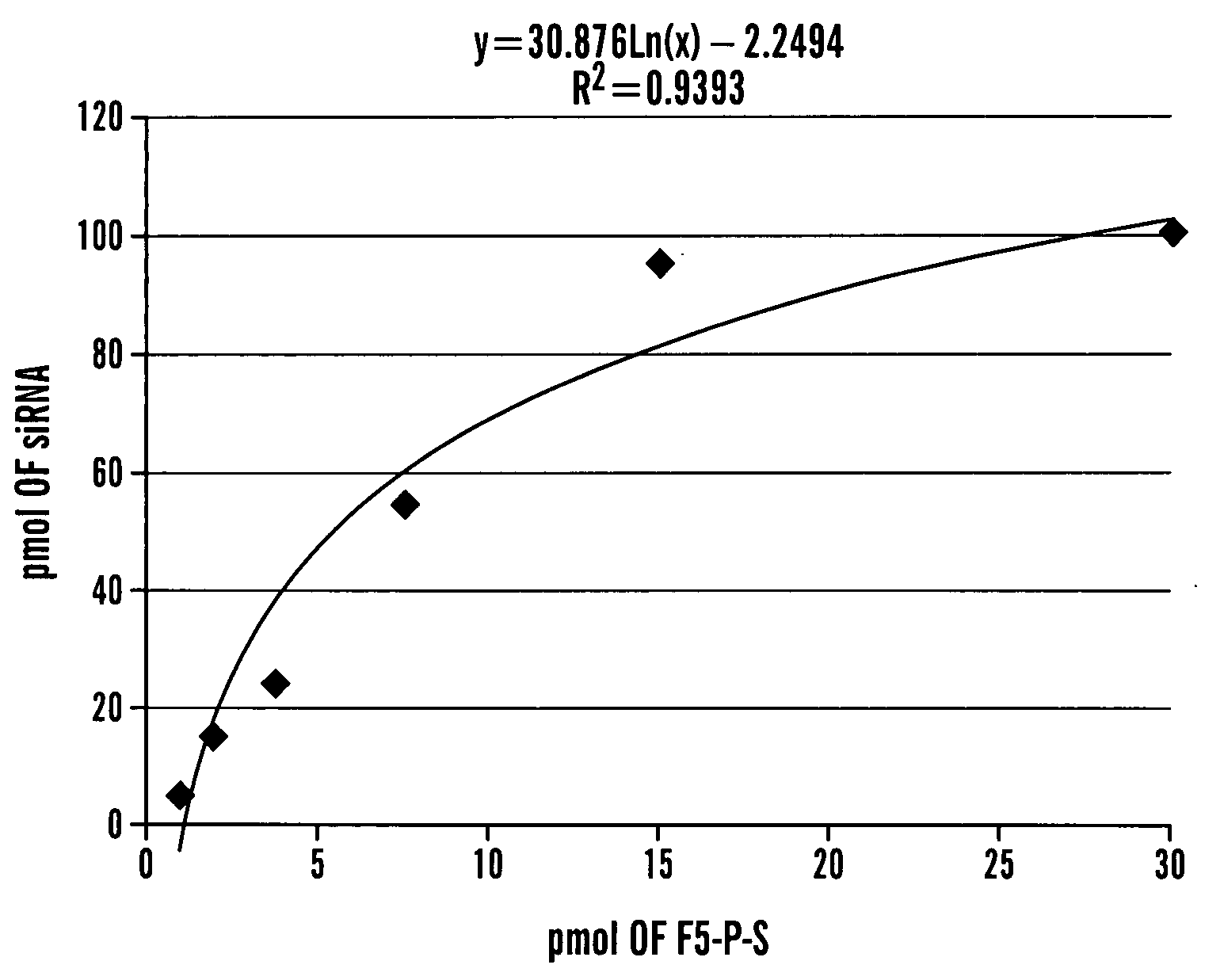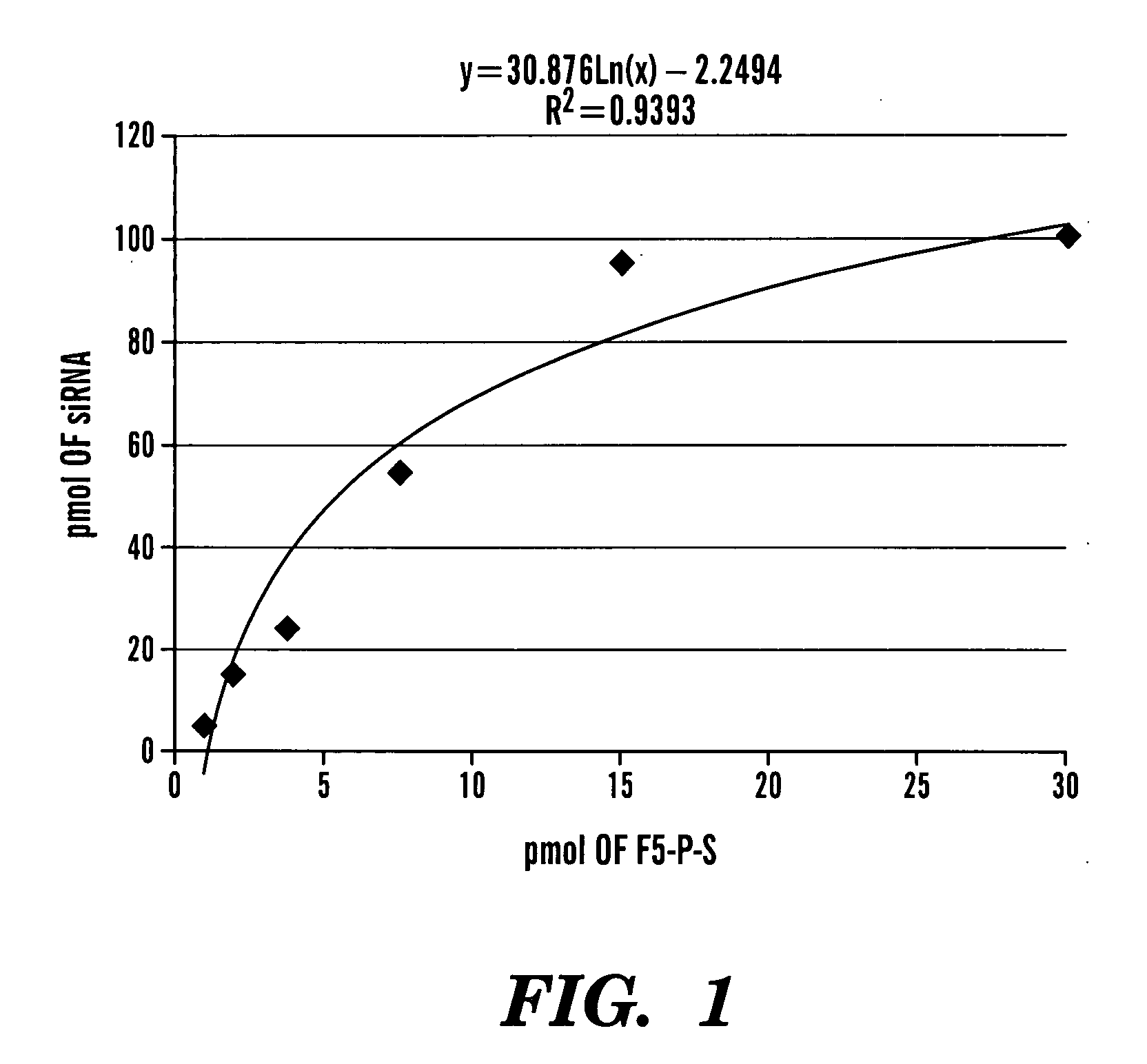Method of Delivering Rna Interference and Uses Thereof
a technology of rna interference and interference, applied in the direction of dna/rna fragmentation, drug composition, peptide, etc., can solve the problems of inability to generally be used to deliver sirnas, the delivery of rna interference agents, including mirnas and sirnas, has proved to be bottleneck, and the amount of rna interference administered into a subject in need of treatment can be minimized, and the potential side effects o
- Summary
- Abstract
- Description
- Claims
- Application Information
AI Technical Summary
Benefits of technology
Problems solved by technology
Method used
Image
Examples
example 1
[0118]Recent studies have demonstrated a promising therapeutic potential of duplex small interfering RNAs (siRNA) in prevention and treatment of infectious disease, cancer and neurodegenerative disease in vitro. However, the major hurdle in therapeutic application of siRNA is how to steer the molecule into a desired cell population to achieve maximal therapeutic effect and avoid non-specific silencing or other toxicity in bystander cells.
[0119]Since duplex siRNAs cannot choose their own cellular targets, it is necessary to design a “guiding missile” to deliver the molecules. Cell surface receptors have been explored as potential targets for gene delivery. A fusion protein composed of a human single-chain antibody fragment (ScFv) at the N-terminus with full length or truncated human protamine polypeptide at the C-terminus can bind RNA and deliver it into target cells expressing the corresponding cell surface protein recognized by the antibody (US 2004 / 0023902). Alternatively, the fus...
example 2
[0136]We evaluated the feasibility of applying F105-protamine to deliver siRNA into specific cell population not only in vitro but also in vivo. This evaluation was performed in a melanoma mouse model, but any other model animal could have been used for this first step evaluation, and the results are readily applicable to, for example, delivering siRNAs to humans in need of specifically targeted gene silencing. FIGS. 9A and 9B show that F105-P delivers c-myc, MDM2 and VEGF siRNAs into gp160-B16 tumors in vivo by intratumoral (FIG. 9A) and intravenous (FIG. 9B) injection and reduces tumor growth.
[0137]We engineered mouse melanoma B16 cells to express gp160 stably and inoculated them subcutaneously (s.c.) into the right flank of C57 / BL6 mice at 5×106 cells per mouse. On day 0, 1, and 3 after cell inoculation, mice were injected s.c. (FIG. 9A) into the right flank, where the tumor cells were implanted, or i.v. (FIG. 9B) with either a combination of siRNA (2 duplexes of c-myc siRNA, mdm...
example 3
Materials and Methods
[0140]siRNAs siRNAs were synthesized using 2′-O-ACE-RNA phosphoramidites (A4 grade, Dharmacon Research). siRNAs directed against fas and EGFP were as previously described6. The sense and anti-sense strands of siRNAs were:
c-myc #127:5 -GAACAUCAUCAUCCAGGAC-3′ (sense, SEQID NO:13);3′-CUUGUAGUAGUAGGUCCUG-5′ (antisense,SEQ ID NO:14);c-myc #227: 5′-ACUCGAACAGCUUCGAAAC-3′ (sense, SEQID NO:15);3′-UGAGCUUGUCGAAGCUUUG-5′ (antisense,SEQ ID NO:16)VEGF28: 5′-CGAUGAAGCCCUGGAGUGC-3′ (sense, SEQ IDNO:17);3′-GCACUCCAGGGCUUCAUCG-5′ (antisense,SEQ ID NO:18);MDM226: 5′-GCUUCGGAACAAGAGACUCdTdT-3′ (sense, SEQID NO:7);3′-dTdTGGUUGUGACGAAUGCGAAU-5′ (antisense, SEQ IDNO:, SEQ ID NO:8);andpp32 (ANP32A)29: 5′-AAGAAGCUUGAAUUAAGCGdTdT-3′(sense, SEQ ID NO:11);3′-dTdTUUCUUCGAACUUAAUUCGC-5′ (antisense,SEQ ID NO:12)Ku70: 5′-ACGGAUCUGACUACUCACUCAdTdT-3′ (sense,SEQ ID NO:19);3′-dTdTUGCCUAGACUGAUGAGUGAGU5′ (antisense,SEQ ID NO:20)
[0141]Fluorescent siRNAs directed against CD4 labeled with FITC at t...
PUM
| Property | Measurement | Unit |
|---|---|---|
| Interference | aaaaa | aaaaa |
| Surface | aaaaa | aaaaa |
Abstract
Description
Claims
Application Information
 Login to View More
Login to View More - R&D
- Intellectual Property
- Life Sciences
- Materials
- Tech Scout
- Unparalleled Data Quality
- Higher Quality Content
- 60% Fewer Hallucinations
Browse by: Latest US Patents, China's latest patents, Technical Efficacy Thesaurus, Application Domain, Technology Topic, Popular Technical Reports.
© 2025 PatSnap. All rights reserved.Legal|Privacy policy|Modern Slavery Act Transparency Statement|Sitemap|About US| Contact US: help@patsnap.com



